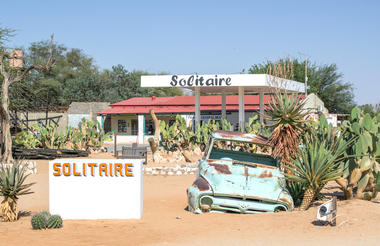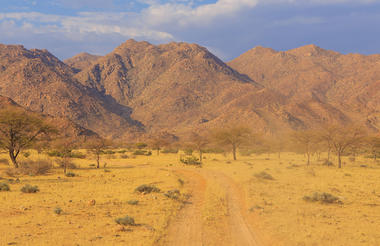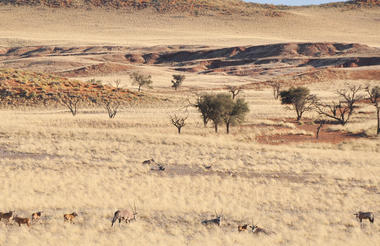With its well-developed infrastructure, some of the best tourist facilities in Africa and an impressive list of breathtaking natural wonders, touring Namibia is truly a pleasure. Visit the capital of Windhoek and the lovely coastal town of Swakopmund to discover remnants of the country’s German influence, reflected in the architecture, culture, cuisine and the annual Oktoberfest celebrations. To properly appreciate this extraordinary country, you will have to venture out of the cities to explore the remarkable natural landscapes Namibia has to offer. These include: the impressive Fish River Canyon Park; the vast Etosha National Park teeming with local subspecies, such as desert lions, desert elephants and the Hartmann's Mountain Zebra; the hauntingly beautiful Kalahari Desert; and of course the Namib Desert stretching for nearly 1000 km along the magnificent Atlantic coastline. Namibia is an ideal destination for travellers seeking an unforgettable African experience in a uniquely beautiful untamed wilderness.
Namibia’s capital, Windhoek, is a cosmopolitan city with an abundance of restaurants, shops, entertainment venues and accommodation. Windhoek is clean, safe and well-organised. The city centre is an interesting architectural mix of historical and modern buildings. The colonial legacy is still alive in its many German eateries and shops and the fairly widespread use of the German language.
City centre sights within easy walking distance: the Alte Feste (Old Fortress) museum; Christuskirche (Christ Church), consecrated in 1910; Tintenpalast (built in 1912/1913 as the seat of the colonial government and nicknamed Ink Palace), which is part of the parliamentary complex; the massive Independence Memorial Museum and the imposing contemporary building of the Supreme Court.
The international airport is 40 km east of Windhoek.
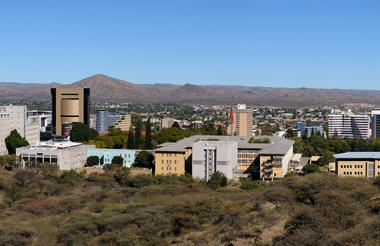
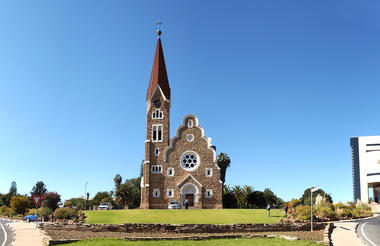

The Kalahari Basin covers most of Botswana and large parts of Namibia and South Africa. The name Kalahari means 'the great thirst' and describes the world’s largest continuous area of sand. It is an exceptionally beautiful semi-desert. In Namibia it is characterised by red dunes, acacia trees and wispy, mostly golden grass. The wide variety of wildlife includes gemsbok, impala, jackal and cheetah, not to forget the famous Meerkat. In all three countries the Kalahari is the last bastion of the indigenous San people who lived as hunter-gatherers in the whole of southern Africa before the modern world started to take over.


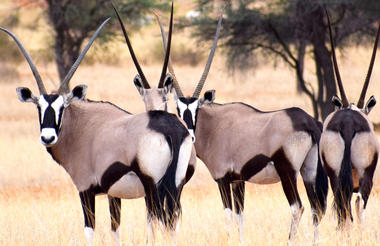
The Fish River Canyon is the most impressive natural wonder in southern Namibia. The canyon starts near Seeheim in the lower reaches of the Fish River and ends 160 km further south at Ai-Ais. It is an awe-inspiring gorge that meanders through the fissured Koubis massif at a depth of up to 550 metres. The Fish River Canyon is the second largest canyon in the world.
The canyon started to form about 500 million years ago during a pluvial episode – i.e. a period of intense rainfall. The huge gorge was not only created by water erosion, however, but also by the collapse of the valley bottom due to tectonic movement and by glaciation during the Karoo Ice Age.
The Fish River Canyon is part of the Ai-Ais/Richtersveld Transfrontier Park. The entrance gate is at the Hobas Campsite, from where it is 10 kilometres to the canyon and the most stunning view of the famous Hell's Bend.
The 86 km Fish River Canyon hike is very popular. But it is a tough challenge of 4-6 days and aspiring hikers have to prove their physical fitness with a medical certificate when they apply for a permit from Namibia Wildlife Resorts in Windhoek. Due to soaring temperatures during the summer months, the trail is open only from May to September.
Much easier, but no less scenically beautiful hikes are offered in the adjacent private nature reserves Canyon Nature Park and Gondwana Canyon Park, which also have excellent accommodation.



Set in a unique geographical location, the harbour town of Lüderitz is almost like a small stronghold of civilisation sandwiched between the thundering Atlantic Ocean and the arid Namib Desert. Lüderitz was the starting point of German colonisation in 1883. The historic buildings in Bismarck Street as well as Goerke House, Kreplin House and Felsenkirche (Church on a Rock) are remnants of that time. These days Lüderitz is famous for crayfish and oysters – and above all the nearby ghost town of Kolmanskop. Built on the wealth of diamonds early last century, Kolmanskop, some 10 km east of Lüderitz, was a thriving settlement for a brief period of time. It was largely abandoned during the 1930s and is being claimed back by the desert dunes ever since.
Activities: Explore the ghost town of Kolmanskop, one of the most fascinating attractions in this area; brave the elements and visit the windswept beaches which are home to flamingos, seals and penguins; venture to Diaz Point and see the stone cross that Portuguese seafarer Bartolomeu Dias erected in 1488; go on a catamaran cruise in Lüderitz Bay; join a day excursion into Sperrgebiet National Park to the deserted diamond mining settlement of Pomona and the massive Bogenfels rock arch on the coast south of Lüderitz.
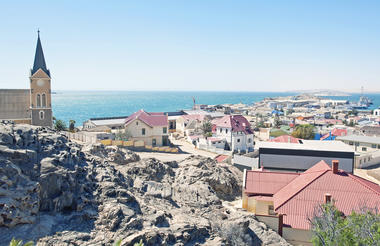
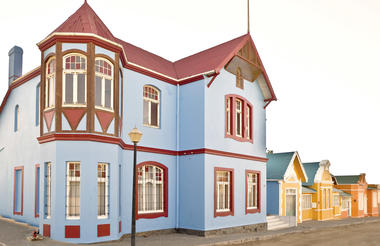
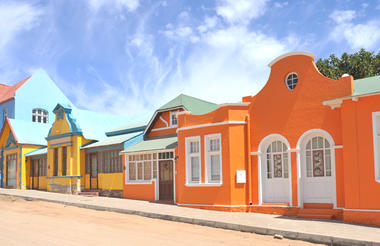
Tucked away in the rocky Aus Mountains on the fringe of the Namib plains, the small village of Aus is located in the south-western ǁKaras Region. The arid surroundings are known for their unique botanical diversity. Aus lends itself as an excellent base from which to explore the area and view the main attraction: the feral horses of the Namib Desert, which run wild and free on the sparsely vegetated plains. Catch a glimpse of these desert-adapted creatures at the water trough at Garub just 20 km away from the village.
Activities: Experience the Succulent Karoo on a visit to the beautiful Gondwana Sperrgebiet Rand Park, home to the most biodiverse desert in the world; take a scenic hike to discover fascinating indigenous fauna and flora; view the vast desert landscape from the back of a horse; camp under the dazzling Namibian night sky.



The desert town of Solitaire, in the south-western Khomas Region of central Namibia, is like a small oasis. There is not much to do or see in this tiny village, other than stop for refreshments and filling up with petrol. Solitaire boasts the only petrol station, general store and post office between Sossusvlei and Walvis Bay. There is also a small bar and a bakery famous for its apple pie – said to be the best in the country – as well as a luxury lodge, a motel and a campsite.
Activities: Enjoy a scenic sundowner with spectacular views of the Namib Desert; take time for a hike; go biking through unspoilt natural scenery; visit the local cheetah sanctuary.
